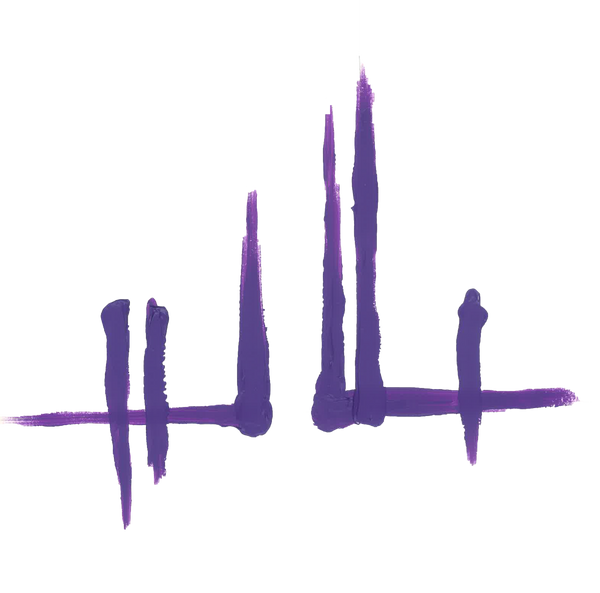“If your church is sacred, so is our sister; if our sister is not sacred, neither is your church.” The grand coësre to the bishop of Paris. Victor Hugo, Notre-Dame-de-Paris.
The canvas is triangular in format, point downwards; on a red background, revealing the touch effects, a female figure with raised arms, in a praying position, looks upwards; his face is distressed. The woman is naked, veiled in a blue fabric. A breast is visible, as well as the navel.
The position takes up the very ancient iconography of the praying woman, arms extended towards the sky. The blue veil recalls the figure of the Virgin, and the painful face the pathos-filled expression of the Mater Dolorosa. Ancient figure of the grieving mother, which we find as well in the figure of Ishtar, Isis and Mary, which tells of the pain caused by the death of a loved one (child, husband) or following a catastrophe (like the destruction of a city [2] ). Through an exacerbated pathos, the figure of the Mater Dolorosa evokes the violence and the strength of her affectivity.
The visible breast reminds us that the female body is nourishing, and that this is its primary function. The navel also refers to motherhood, to the creative force of the female body. Like the nursing deities of ancient pagan religions [3] , woman “embodies nature, insofar as she produces life on the one hand, and her secrets remain impenetrable on the other. And lifting the veil of the goddess thus became the metaphor for the quest for truth in the posterity of Heraclitus [4] , until modern times [5] . » According to this ancient historian, “ Phusis kruptesthai philei ”: Nature likes to hide. This statement creates debate between authors who claim to lift the veil with which the secrets of Nature are covered, and those who, on the contrary, believe that this would be a fault, that we must respect this veil and not lift it.
This woman implores in the face of all the judgments and criticism that women receive about their bodies, between excessive sexualization and ridiculous prudishness, a deep incomprehension plays out. The woman thus appears in her simplest and most natural form, thus opposing the veil, symbol of the numerous constraints imposed on women's bodies for several thousand years [6] . The bare-headed woman represents immodesty, unlike the veiled figure, sacred in Christianity: Paul, in the Epistle to the Corinthians, enjoins women who prophesy in sacred space to cover their heads. “Man is the image and glory of God”, he writes: he therefore has no need to veil himself. On the other hand, because woman "is the glory of man" and "man was not created for woman, but woman for man", the latter "must carry on her head the mark of his dependence.
Here the veil does not hide the body but participates in its unveiling, as a reappropriation of the body and therefore a symbol of freedom. Individual freedom where the body belongs to the person who owns it and symbolic reflection around the woman's body as the origin of the world. It is this double implication, natural and cultural, which is highlighted here through the subject's supplication: why is the female body perceived as a threat, when it is the original and creative matrix? Why are women killed and oppressed? How can we stop these oppressions?
This canvas takes the form of an inverted triangle, reminiscent of the female pubic triangle, as opposed to the male triangle pointing upwards, referring to God the Father. Here, the supplication is directed towards the celestial, without addressing a particular god. Moreover, the light in this work is not overhead: it comes from the right, as if the woman were abandoned to her fate, with no one to turn to.
The suffering, the nudity, the imploration of this allegory which wants to denounce the incomprehension in the face of all the violence committed by society against women: domestic violence, sexual violence, verbal attacks, street harassment, salary differences, injunctions to beauty, slimming, etc.
This work questions the way we look at women and their bodies: it is a political work that encourages the viewer to take sides. She invites women to escape from the relationship of male-female domination, which they also maintain; and men to question their participation in this system, through action or through indifference.
[1] “Hosanna” comes from Hebrew: הוֹשַׁענָא hošanna “grace, save” and from Greek: ὡσαννά hôsanná
[2] For Samuel Noah Kramer in his book Weeping Goddess: Sumerian Prototypes of the Mater Dolorosa1, “It was after the destruction of the civilization of Ur III, around 1900 BC, that the pathetic image of the “crying goddess” in Sumerian literature.” https://fr.wikipedia.org/wiki/Mater_dolorosa
[3] Isis the mother breastfeeding her son Horus; Artemis feeding Nature with several rows of breasts
[4] Heraclitus is a Greek philosopher, born in Ephesus around 576 BC. BC, died around 480 BC. BC linked to the pre-Socratics.
[5] https://www.cairn.info/revue-l-enseignement-philosophique-2013-1-page-62.htm
[6] “[The veil] has in fact been present throughout the Mediterranean basin since the dawn of time since the first law requiring married women to cover their heads dates back to the Mesopotamian era, i.e. 5,000 years ago approximately. » https://www.unige.ch/campus/numeros/121/recherche3/#:~:text=Premier%20constat%3A%20l’usage%20du,y%20a%205000%20ans%20environ
%20years%20around


3 comments
Comme quoi, dans une œuvre, rien n’est laissé au hasard et tout a sa place, en l’occurrence, en effet, une toile triangulaire qui pointe vers le bas. Je souhaite tout le succès !
La toile est magnifique, la signification également. C’est une œuvre d’art et le format sort du commun. J’adore.
Explications des intentions de l’artiste très intéressantes!